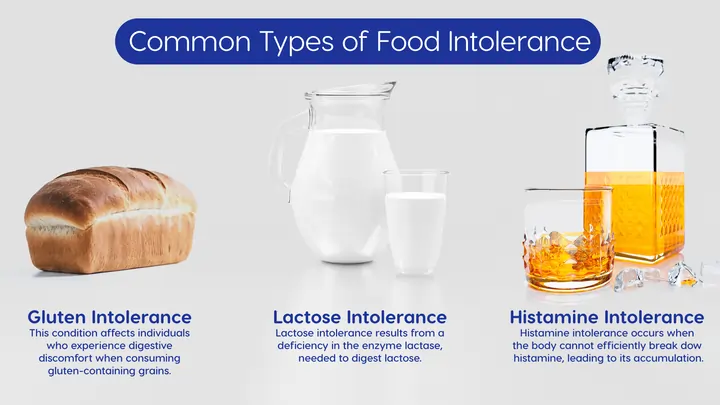Archives

Food is a source of nourishment and pleasure for many of us, but for some, it can be a source of discomfort and distress due to food intolerance. Food intolerance, often confused with food allergies, is a prevalent issue that affects a significant portion of the population. In this comprehensive guide, we will explore the nuances of food intolerance, including its symptoms, causes, diagnosis, and treatment options.
What is Food Intolerance?
Difference Between Food Intolerance and Food Allergy:
It’s crucial to distinguish food intolerance from food allergies. Food allergies involve the immune system’s response to proteins in particular foods and can lead to severe reactions like anaphylaxis. Conversely, food intolerance does not involve the immune system and typically causes milder, digestive-related symptoms.Common Types of Food Intolerance:
Several common types of food intolerance exist, each with specific triggers:What Causes Food Intolerance?
The causes of food intolerance can vary widely. Some common factors include enzyme deficiencies, food additives, chemical sensitivities, and underlying gastrointestinal disorders. It’s essential to provide a comprehensive view of potential causes.
Symptoms of Food Intolerance:
Food intolerance manifests in various ways. Symptoms may include gastrointestinal distress (bloating, gas, diarrhea), skin problems (rash, itching), headaches, fatigue, mood changes, respiratory symptoms, and joint pain. Highlighting the diversity of symptoms helps readers recognize potential food intolerance issues.
How Important Is It to Diagnose Food Intolerance?
Diagnosing food intolerance is crucial for several reasons:
Advantages of Having the Food Allergy Test at Home
Recent advances in healthcare technology have made at-home food intolerance testing accessible to individuals seeking answers to their dietary discomfort. This approach offers several distinct advantages over traditional testing methods, including convenience, privacy, and timely results. Here, we delve into these advantages to help readers understand the potential benefits of using reliable and approved at-home testing kits.
How it Works:
- Individuals can order an approved at-home testing kit online or from a local pharmacy, and it is delivered directly to their doorstep.
- The testing process is typically user-friendly, with clear instructions provided in the kit. It often involves collecting a sample, such as a blood sample or a hair sample, as specified by the test.
- After collecting the sample, individuals can send it to a certified laboratory for analysis using prepaid postage or designated drop-off points.
- Results are usually provided digitally within a reasonable timeframe, allowing individuals to access their test results conveniently online or through a mobile app.
Benefits:
- Time Savings: At-home testing eliminates the need for multiple visits to healthcare facilities, saving individuals valuable time.
- Reduced Wait Times: Traditional medical testing may involve long waiting periods for appointments and results, while at-home tests typically offer faster turnaround times.
- Minimal Disruption: Individuals can complete the testing process without disrupting their daily routines or work schedules.
How it Works:
- With at-home testing, individuals can conduct the entire process in the comfort and privacy of their own homes.
- There is no need to discuss symptoms or health concerns with healthcare providers or laboratory staff unless individuals choose to do so.
- Results are typically delivered digitally or via a secure online platform, further ensuring confidentiality.
Benefits
- Comfort: Testing at home provides a comfortable and familiar environment, reducing potential stress or anxiety associated with medical settings.
- Confidentiality: Individuals can maintain their health-related information in private, sharing it only with those they choose to inform.
- Flexibility: At-home testing allows individuals to control the timing and location of the test, making it convenient for those with busy schedules.
How it Works:
- At-home test kits are designed for efficiency. Once the sample is collected, it is sent to a certified laboratory for analysis promptly.
- Many at-home testing companies prioritize rapid processing of samples to provide results within a reasonable timeframe.
- Individuals can receive their results digitally, usually within days or weeks, depending on the specific test and the processing time required.
Benfits:
- Reduced Anxiety: Quick access to results can alleviate anxiety associated with prolonged waiting periods.
- Prompt Decision-Making: With timely results, individuals can make informed dietary choices sooner, potentially reducing discomfort.
- Faster Treatment Initiation: In cases where dietary modifications or other interventions are needed, timely results facilitate quicker initiation of treatment.
Ensuring Reliability:
It is crucial to emphasize that while at-home food intolerance testing offers these advantages, it should be conducted using reliable and approved testing kits. Not all at-home tests are created equal, and accuracy is paramount when making important dietary decisions based on test results.
Consult with a Healthcare Provider: While at-home testing can provide valuable insights, it is essential to consult with a healthcare provider for a comprehensive assessment and guidance on interpreting results.
Treatment Options for Food Intolerance:
Complications of Food Intolerance:
You might also like
The Diagnostic Value of CT Scans
Lab test at Home Food Intolerance Doctor at Home Physio
The Vital Role of Vaccinations: Essential for All Ages
Lab test at Home Food Intolerance Doctor at Home Physio
Breastfeeding Awareness Week: Simple Tips for New Moms
Lab test at Home Food Intolerance Doctor at Home Physio

